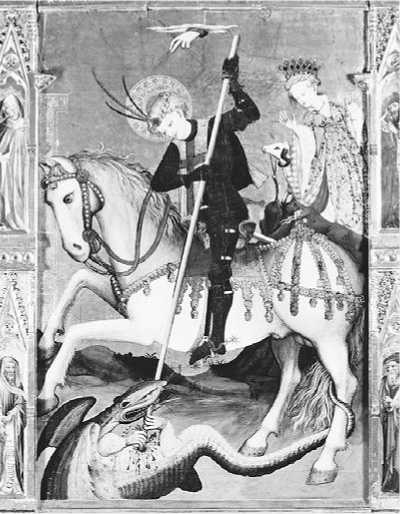Perhaps taking his cue from the Apostle Paul, who had lived about four centuries earlier, Patrick never spoke out actively against slavery, despite the fact that he had been a
A Gallery of Saints

The Middle Ages, as well as the late ancient period, produced literally thousands of figures who later became recognized as saints, Christians so devout that they served as a model to others. There were Roman Catholic saints such as Bernard of Clair-vaux or Joan of Arc, and there were Eastern Orthodox saints such as Cyril and Methodius; then there were figures such as Augustine who were revered throughout the Christian world (see entries).
Some saints are particularly well known, primarily through popular legends that have little to do with the actual people themselves. Such is the case with St. Valentine, whose feast day on February 14 is even more well known than Patrick's on March 17. Perhaps these two events became so popular because they break up the dreariness of wintertime; in any case, the romantic associations of Valentine's Day have as little to do with the real St. Valentine as the feasting and drinking on St. Patrick's Day have to do with that saint.
There were at least three St. Valentines, one of whom lived in North Africa.
Of this one little is known, but slightly more information is available about the other two, one of whom was a priest in Rome, the other a bishop in another part of Italy (they may, in fact, have been a single person). Both—like their namesake in Africa—were martyred, or killed for their faith. The Roman priest seems to have died in 270, during persecutions under Emperor Claudius II. All three Valentines had feast days on February 14, when it was said that birds begin to pair off. There was also a pagan Roman custom associated with mid-February, whereby young men would draw the names of girls and pair up with them.
Then there is the saint associated with the most popular holiday of all: St. Nicholas, who as Santa Claus became a symbol of Christmas. In fact St. Nicholas was a bishop in Asia Minor (modern-day Turkey) during the late third century and early fourth century. The only possible link with Santa Claus is the fact that he was renowned for doing good deeds, and that he became a patron saint of children.
Slave. He saw his mission as primarily a spiritual rather than a political one. Nonetheless, he expressed concern for the slaves who converted to Christianity, because he knew that they were far more vulnerable to persecution for their faith.
Many Irish leaders at that time were hostile to the new faith, and at one point Patrick and others with him were seized and imprisoned by a group of local kings. They were released two weeks later, but some time afterward, Patrick

St. George slaying a dragon. Reproduced by permission of the Corbis Corporation.
These characteristics led people in Western Europe to give gifts in his name at Christmastime, and eventually he was linked with a pagan figure from Scandinavia known as "Sint Klaes." During the nineteenth century, the Santa Claus legend began to take hold in America, where it bore almost no relation to the original St. Nicholas.
St. Nicholas also became one of the patron saints of Russia, along with St. Andrew. One version of the Russian flag used the cross of St. Andrew, a white X on a navy-blue field. This was also used by Scotland, which likewise claimed Andrew as a patron saint. Neighboring England's patron saint was George, and when these two countries were united as Great Britain in the early 1700s, the two saints' crosses helped form that nation's flag, the Union Jack.
The "real" St. George, like St. Nicholas, lived during the persecutions under Diocletian, the last Roman emperor before Constantine converted to Christianity in 312. It was said that George was a soldier beloved by Diocletian, but when he proudly announced the fact that he was a Christian, the emperor had him tortured and beheaded. Pictures of St. George typically show him in a classic medieval scene, as a knight slaying a dragon to rescue a lady. In Christian symbolism, however, this image has spiritual rather than romantic meaning: the dragon represents wickedness, and the lady stands for truth or the church.
Managed to enrage the king of Tara. Patrick compared Tara, an Irish city, to Babylon, which was both the city where the Israelites were held captive for many years, and also a symbol of wickedness.
Tara had a pagan spring festival inaugurated each year by the king's lighting of a bonfire. However, one year the Christian holiday of Easter, commemorating Christ's death and resurrection, fell at the same time, and Patrick lit an East-
Er bonfire just before the king was supposed to light his. The king and his magicians, a later biographer wrote, went to attack Patrick, but the lead magician was suddenly pulled up into the air, then tossed to his death.
This miraculous and no doubt fictitious occurrence failed to stir the magicians, so Patrick engaged in a contest of miraculous powers with another magician. He triumphed, and the king of Tara made a half-hearted conversion to Christianity. The conversion became more sincere after the magician challenged one of Patrick's converts to another test, and failed miserably: according to this legend, both men were shut up in a house that was burned to the ground, and the Christian survived while the magician burned to death.




 World History
World History









